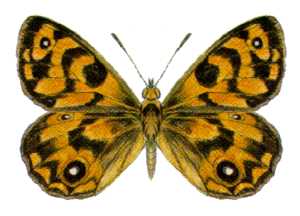Bright-eyed brown facts for kids
Quick facts for kids Bright-eyed brown |
|
|---|---|
 |
|
| Scientific classification | |
| Kingdom: | |
| Phylum: | |
| Class: | |
| Order: | |
| Family: | |
| Genus: |
Heteronympha
|
| Species: |
H. cordace
|
| Binomial name | |
| Heteronympha cordace (Geyer, 1832)
|
|
| Synonyms | |
|
|
The bright-eyed brown butterfly, also known by its scientific name Heteronympha cordace, is a special brown butterfly found only in Australia. It was first described by a scientist named Carl Geyer in 1832.
Contents
About the Bright-Eyed Brown Butterfly
What Does It Look Like?
The bright-eyed brown butterfly has a wingspan of about 38 to 42 millimeters (around 1.5 to 1.7 inches). Female butterflies are usually a bit bigger than males. They also have a wider body part called the abdomen.
The top side of their wings is dark brown or black with bright orange or brownish-orange patterns. These patterns include two special "eyespot" markings. One is near the wing tip (subapical) and the other is near the bottom corner (subtornal). Both eyespots are black with a blue center.
The underside of the wings is lighter in color. It has even more orange areas than the top side.
Where Does It Live?
The bright-eyed brown butterfly lives in different, separate areas across Australia. You can find it in New South Wales, southern Victoria, southeastern South Australia, and Tasmania.
These butterflies live in swampy places. They can be found high up in the Great Dividing Range mountains or closer to the coast. Sadly, this butterfly is not very common anywhere. Many groups of them have disappeared because their homes (habitats) have been destroyed.
Life and Habits of the Butterfly
How It Flies and What It Eats
Adult bright-eyed brown butterflies fly slowly and gently. They usually stay close to the ground. They fly near the plants where their young (larvae) eat. They also like to be near other plants like Melaleuca and Leptospermum, which grow near their breeding spots.
These butterflies have one generation each year. This means they complete their whole life cycle (egg to adult) once a year. You can mostly see the adult butterflies flying from late December to February.
Where It Prefers to Live
This butterfly loves areas with sedges (grass-like plants) and low shrubs. These places are often found in swamps or along creeks. They especially like areas with lots of their favorite food plant for their larvae.
They mostly live at altitudes from 600 to 1800 meters (about 2,000 to 6,000 feet) above sea level. However, in Tasmania, they can even be found at sea level.
The Butterfly's Life Cycle
The main food plant for the bright-eyed brown butterfly's larvae (caterpillars) is a plant called Carex appressa. The female butterfly lays her eggs one by one, or just a few at a time. She places them on the underside of the lower leaves of the Carex appressa plant.
- Eggs: The eggs are tiny, about 0.8 millimeters (0.03 inches) wide. They are green, almost perfectly round, and have thin lines running along them.
- Larva (Caterpillar): The caterpillar is green or greenish-brown and grows to about 25 millimeters (1 inch) long. It has a darker line down its back and lighter lines on its sides. Its head is a reddish-brown or mottled brown color.
- Pupa: The pupa (the stage before it becomes an adult butterfly) is green with greenish-yellow wings. It is about 14 millimeters (0.55 inches) long. The pupa hangs upside down from a low leaf of the host plant, or a plant nearby. It attaches itself using a special hook-like part called the cremaster.
Different Types of Bright-Eyed Brown Butterflies
Scientists have identified a few different types, or subspecies, of the bright-eyed brown butterfly. These are slightly different groups found in various locations:
- Heteronympha cordace cordace (found from southern New South Wales to Mount Buangor in Victoria)
- Heteronympha cordace wilsoni Burns, 1948 (found in the Grampians, Victoria)
- Heteronympha cordace comptena Couchman, 1954 (found in central and west coast Tasmania)
- Heteronympha cordace kurena Couchman, 1954 (found in the Cradle Mountains, Tasmania)
- Heteronympha cordace legana Couchman, 1954 (found in Lake Leake and Mount Barrow, Tasmania)

